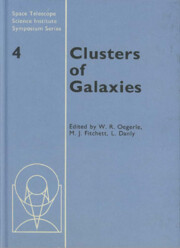Book contents
- Frontmatter
- Contents
- Preface
- Participants
- Chapter 1 Cosmology and Cluster Formation
- Chapter 2 Clusters of Galaxies: Structure, Infall, and Large-Scale Distribution
- Chapter 3 Cosmogony with Clusters of Galaxies
- Chapter 4 Cosmogony and the Structure of Rich Clusters of Galaxies
- Chapter 5 The Dark Matter Distribution in Clusters
- Chapter 6 The Effect of the Cluster Environment on Galaxies
- Chapter 7 Evidence for Gas Deficiency in Cluster Galaxies
- Chapter 8 Properties of Galaxies in Groups and Clusters
- Chapter 9 Dynamical Evolution of Clusters of Galaxies
- Chapter 10 Hot Gas in Clusters of Galaxies
- Chapter 11 Hydrodynamic Simulations of the Intracluster Medium
- Chapter 12 Evolution of Clusters in the Hierarchical Scenario
- Chapter 13 Distant Clusters as Cosmological Laboratories
- Chapter 14 Future Key Optical Observations of Galaxy Clusters
- Chapter 15 Cluster Research with X-ray Observations
- Plate section
Chapter 15 - Cluster Research with X-ray Observations
Published online by Cambridge University Press: 06 July 2010
- Frontmatter
- Contents
- Preface
- Participants
- Chapter 1 Cosmology and Cluster Formation
- Chapter 2 Clusters of Galaxies: Structure, Infall, and Large-Scale Distribution
- Chapter 3 Cosmogony with Clusters of Galaxies
- Chapter 4 Cosmogony and the Structure of Rich Clusters of Galaxies
- Chapter 5 The Dark Matter Distribution in Clusters
- Chapter 6 The Effect of the Cluster Environment on Galaxies
- Chapter 7 Evidence for Gas Deficiency in Cluster Galaxies
- Chapter 8 Properties of Galaxies in Groups and Clusters
- Chapter 9 Dynamical Evolution of Clusters of Galaxies
- Chapter 10 Hot Gas in Clusters of Galaxies
- Chapter 11 Hydrodynamic Simulations of the Intracluster Medium
- Chapter 12 Evolution of Clusters in the Hierarchical Scenario
- Chapter 13 Distant Clusters as Cosmological Laboratories
- Chapter 14 Future Key Optical Observations of Galaxy Clusters
- Chapter 15 Cluster Research with X-ray Observations
- Plate section
Summary
Abstract. Past X-ray surveys have shown that clusters of galaxies contain hot gas. Observations of this hot gas yield measurements of the fundamental properties of clusters. Results from a recent study of the X-ray luminosity function of local Abell clusters is described. Future surveys are discussed and the potential for studying the evolution of clusters is analyzed.
INTRODUCTION
The systematic study of clusters began with the surveys of Abell (1958) and Zwicky et al. (1968) who each created well defined catalogues according to specific definitions of the object class. In particular Abell defined clusters as overdensities of galaxies within a fixed physical radius around a center, classifying such objects as a function of their apparent magnitude (distance) and of their overdensity (“richness”).
The first X-ray survey of the sky by the UHURU X-ray satellite showed that “rich” nearby clusters were powerful X-ray sources (Gursky, et al. 1971, Kellogg et al. 1972). Subsequent spectroscopic studies detected X-ray emission lines of highly ionized iron and demonstrated that the X-ray emission was produced by thermal radiation of a hot gas with temperatures in the range of 30 to 100 million degrees (Mitchell et al. 1976, Serlemitsos, et al. 1977).
With the launch of the HEAO1 and the Einstein Observatories, surveys of significant samples of nearby clusters demonstrated that as a class, clusters of galaxies are bright X-ray sources with luminosities between 1042 and 1045 ergs/sec (Johnson, et al. 1983, Abramopoulos and Ku 1983, and Jones and Forman 1984).
- Type
- Chapter
- Information
- Clusters of Galaxies , pp. 377 - 395Publisher: Cambridge University PressPrint publication year: 1990



